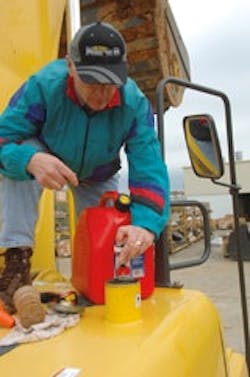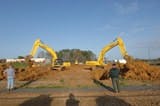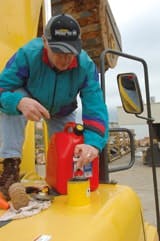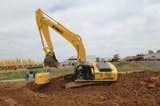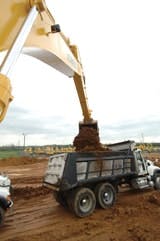On-Site Testing Reveals New Kobelco's Strengths
Greg Bair, president of Greg Bair Track Hoe Service in Overland Park, Kan., specializes in demolishing concrete bridges (using large excavators with breakers) in an ecologically sound manner — to the point of crushing debris to 1-inch minus and giving it away to save haul-away costs and to preserve landfill space.
The test machines, both low-hour units that were checked for pertinent specifications before the comparisons, used standard digging arms (10 feet 10 inches) and identical heavy-duty, 48-inch-wide, 2-cubic-yard buckets.
The amazing power of hydraulic force is evident as the SK350LC, positioned on a 25-degree cross-slope, swings a nearly 20,000-pound test weight 90-degrees uphill during the swing-torque test.
The SK350LC's batteries are easily serviced from ground level, along with the air cleaner. The new side-by-side coolers are smaller than those of the predecessor model and can be individually serviced. The air-conditioning condenser is positioned some 5 inches away from the surface of the other coolers so as not to impede airflow.
Refinement in the SK350LC's operator station includes relocation of all switches, throttle and engine-start to the right console; ergonomically redesigned joystick controllers; new monitor with sunshade; adjustable armrests (both vertical and incline); larger foot pedals; front glass that can be raised and stored overhead with one hand; and a removable (and washable) floor mat.
With an 8.75-metric-ton (19,250-pound) counterweight chained to the lifting eye of the bucket, and with the machine in its heavy-lift mode, the operator slowly increased the machine's lift radius (the distance from the center of the load chain to the center of the swing bearing) until the machine's track rollers began to lift off the links (when lifting over the side), or until the rear-most roller began to lift off the link (when lifting over the end). We then compared maximum lift radii machine-to-machine. The 2-percent difference between the machines in over-side lifting we considered negligible; in over-end lifting, however, the SK350LC did exhibit nearly a 9-percent advantage.
The nearly 20,000-pound test weight (an excavator counterweight) provided a reasonable challenge for the test machines.
Equipped with standard digging arms (10 feet 10 inches) and identical heavy-duty, 48-inch-wide, 2-cubic-yard buckets, the test units dug to 10 feet and a bucket-width wide for 30 minutes in their heavy-digging mode. The operators then switched machines and repeated the process. Total trench opened exceeded 550 feet. Since both machines worked an hour, measuring the two respective trenches for each and calculating the excavated volume yielded a per-hour production number. Comparing these numbers, we noted an approximate 5-percent differential, which we consider too small for making judgments about machine productivity; variability in the particular machines used, in soil conditions and in operator performance could easily push the numbers in the opposite direction on another day. Thus, we concluded that the productivity of the two units was essentially equal.
To analyze fuel efficiency, we filled each machine's tank to the bottom of the debris screen before the test run, making certain that each machine, in turn, was in the identical position on the refueling pad. We also checked the temperature of the fuel in the freshly filled tank, then again immediately after the test runs. (Fuel heating — and subsequent expansion — occurs when that portion of the fuel supplied to the engine for cooling and lubricating fuel-system components returns to the tank). Our observation was that the SK350LC's fuel consistently showed a greater (but modest) rise in temperature, perhaps the result of the machine's common-rail fuel system. Using an industry formula, we calculated an approximate fuel-expansion differential between the two units, and that calculation, on average, resulted in our adding 0.42 of a gallon to the amount of fuel (weighed across an electronic scale) actually required to refill the new model's tank after a test run.
Even with this adjustment, however, our data indicated that the SK350LC exhibited an 18-percent advantage in fuel efficiency when trenching, that is, the machine moved 18 percent more material per gallon of fuel than did its predecessor.
With the machine positioned on a 25-degree cross-slope and the 19,250-pound weight chained to its bucket, the operator swung 90 degrees uphill, starting with the weight in front of the tracks. If the swing was successful, then the lift radius was increased and the process repeated until the machine could not swing the weight. By measuring and then comparing the maximum lift radii machine-to-machine, we determined that the SK350LC demonstrated a 7-percent advantage in swing torque, compared to the SK330LC's performance.
With the machines configured as for the trenching study, the operators dug from a shallow trench, then swung approximately 90 degrees to the truck. Each operator used each machine to load eight trucks. The trucks — tandem-axle Mack Granite rear-dumpers hired from Northwest Georgia Paving — requiredsix passes to fill. We timed the machines as they worked, then the trucks were weighed on a certified off-site scale to determine payload. We checked fuel in the same fashion as for the trenching comparison. Our test data indicated that the SK350LC was, on average, about8.5 percent more productive in this application, and that it exhibited a nearly 10-percent advantage in fuel efficiency.
Sometimes, after choosing the flattest spot around to refuel machines during an on-site fuel study, you then discover that the diesel bulk tank is half a mile away — or at least seems that far when lugging five-gallon cans from the tank, to the scale, then to the machine. But when CE editors worked with Kobelco to compare the performance and design of the new SK350LC hydraulic excavator with those of its predecessor, the SK330LC, we were more fortunate. The bulk tank was adjacent to a large concrete pad (perfect for refueling), plus the pad was close to our test site. And as it turned out, the fuel study was among the most revealing of our comparative tests, which also included an analysis of trenching, truck-loading, lifting and swing-torque performance.
The site of our comparative study was Kobelco's Calhoun, Ga., manufacturing plant, where the company builds seven of its excavator models. Calhoun was chosen as the test site, because the two required machines were available there, and because a large open field adjacent to the factory allowed for long trenching runs.
To make testing as unbiased as possible, two independent operators ran the machines during the comparisons: Greg Bair, president of Greg Bair Track Hoe Service in Overland Park, Kan.; and Michael Sager, a principal in T. M. Sager Grading based in Snellville, Ga. The Kobelco crew on site included platform manager Reece Norwood; eastern-region product specialist Troy Hitchcock; director of marketing Edgar Chavez; and brand marketing manager Paul Golevicz. We conducted the test during two days in early April (one day soggy and chilly; the other, fortunately, drier and pleasantly warm).
Results of the comparative tests and our procedures are detailed in sidebars throughout this report, but here's the thumbnail version of our findings: When trenching, the two machines basically worked to a draw, but the new model showed a significant advantage in fuel-efficiency. When loading trucks, the new model showed a modest advantage both in productivity and fuel-efficiency; over-side lifting was a draw, but the new model delivered better numbers for over-end lifting and for swing-torque.
New engine, heavier structures
When contemplating a replacement for the 77,800-pound SK330LC Dynamic Acera, Kobelco was obligated to equip the replacement model with a Tier-3-compliant engine. But along with meeting that obligation, says Kobelco's Norwood, the company also wanted the replacement model to exhibit enhanced "controllability, durability and maintainability."
Thus, in the SK350LC's engine bay resides a new Tier-3-compliant, 7.7-liter Hino J08E-TM diesel engine, which develops 264 net horsepower. This engine replaces the SK330LC's 7.6-liter Mitsubishi engine, which was rated at 247 net horsepower. The new engine, unlike its electronically governed predecessor, uses a common-rail fuel system and a cooled-EGR (exhaust-gas recirculation) system. According to Kobelco's Hitchcock, Hino Heavy Industry Co. was established in 1942 and has been part of Toyota Motor Corp. since 1966, becoming a Toyota subsidiary in 2001.
An integral part of the new engine installation is a refined cooling package. The radiator, hydraulic-oil cooler, and the charge-air cooler are positioned side-by-side in the left-rear compartment and can be serviced individually if the need ever occurs. Similar coolers for the SK330LC were in the same location, but stacked one in front of the other and had to be swung out for cleaning. In addition, debris screens positioned in front of each new cooler can be easily lifted out from the top for cleaning. According to Kobelco, since all three coolers draw the same ambient air, they are actually smaller than those used for the SK330LC.
Along with more horsepower and a more efficient cooling package than its predecessor, the new SK350LC also reflects a more robust structural design. According to Norwood, the SK330LC offered a choice between a standard-duty and a heavy-duty boom and arm — the heavy-duty versions designed for severe-service applications, such as quarry loading and sustained hydraulic-breaker work. But the SK350LC no longer provides this option, using instead the heavy-duty components as standard equipment. To compensate for the added weight of these components, the SK350LC is fitted with a heavier counterweight.
Like its predecessor, though, the new model uses Kobelco's vertical-bar rock guard, which protects the backside of the stick from abrasive material, and it, too, offers an optional long stick (13 feet 7 inches), as well as mass-excavator and long-reach front ends. Buckets also remain the same for the two machines.
Also heavier and more robust for the new model are both its undercarriage, with beefier components throughout; and its carbody, which not only uses thicker material than its predecessor, but also has the ends of its support beams mounted farther toward the ends of the track frames. Says Kobelco's Golevicz, the redesigned carbody enhances fore/aft stability and further compensates for the heavier boom and stick. In total, the SK350LC weighs about 2,000 pounds more in standard trim than its predecessor.
The SK350LC's hydraulic refinement includes the use of slightly larger main pumps that provide an extra 20-plus gallons of flow per minute (155 gpm, compared to the SK330LC's 134 gpm). The SK350LC, as did its predecessor, employs Kobelco's Intelligent Total Control System (ITCS), which, says Golevicz, coordinates engine and hydraulic functions for maximum efficiency.
The overall design of the hydraulic-control system for the machines, however, does differ. The SK330LC used Kobelco's NeuralNet Command System, which employed "fuzzy logic" that, according to Kobelco, allowed the system to recognize various tasks and to automatically respond by adjusting the machine's performance to the job at hand.
Basically, the SK330LC defaulted to its manual mode (which delivered maximum output), unless the operator pushed the "Assist" button to activate the NeuralNet system. When activated, the NeuralNet system used its fuzzy logic to analyze what task the operator was performing, then adjusted hydraulic and engine functions to help accomplish the task most efficiently and comfortably — whether digging, leveling, scattering stone or using the bucket for compacting. In addition, the SK330LC's breaker mode allowed for setting the hydraulic flow rate from in the cab to suit the breaker's requirements.
Working modes for the SK350LC, however, seem more straightforward: an H-mode for heavy digging; an S-mode for potential fuel savings when performing general earthmoving; a B-mode that provides one-way auxiliary flow for a breaker; and an A-mode (auxiliary) that allows two-way/two-pump flow for demolition tools. A standard-equipment auxiliary valve allows switching between the A and B modes from the cab, but the auxiliary piping and controls are optional (although tapped blocks to facilitate piping installation are provided on the boom and stick). In addition, an optional "independent-flow circuit" (using a dedicated gear pump) provides flow for multi-function attachments, such as thumbs and twist buckets.
The new model (as did its predecessor) also has no-time-limit, heavy-lift and power-boost functions. When activated, these functions provide an increase of 10 percent in main hydraulic pressure, and the heavy-lift system also reduces hydraulic flow by 10 percent for added control. Also retained from the predecessor machine's design is an operator-selected independent travel mode, which dedicates one of the machine's two main pumps solely to the travel system in order to maintain constant travel speed even when another hydraulic function is activated.
Overall, says Golevicz, enhanced controllability was a key factor in the design of the SK350LC's hydraulic system. The new model, he says, builds on the already-precise system in the SK330LC (by providing even tighter valve-spool tolerances, for example) to ensure that the new model performs its hydraulic functions smoothly. In fact, says Golevicz, a design goal for the SK350LC was to enable the machine to be equally adept at production earthmoving and fine grading, the latter ability including establishing both the trench bottom and surface contours.
Also high on the list of design objectives for the SK350LC was simplified, more convenient routine maintenance. To that end, Kobelco has designed in ground-level access to all routine service points, except for the engine-oil and swing-motor dipsticks and for the bank of five grease zerks on the boom. The batteries are located in a left-side compartment (with the air cleaner), and at the right-front corner, where the SK330LC housed its batteries, the new model has a conveniently accessed tool box.
Also accessible from ground level are the new remote-mounted filters (in the right-rear compartment) for engine oil, fuel and pilot hydraulics. Greasing chores have been simplified as well, because, except for the bucket pins, all pivots in the digging mechanism require grease only at 500-hour intervals — the result of new bushings and a new grease-retention system. The hydraulic-oil-change interval, under typical operating conditions, is 5,000 hours if the system is maintained with factory-fill oil (Shell Tellus Premium).
Both our guest operators own a number of late-model Kobelco excavators and are, therefore, probably more sensitive than most about picking up on refinement in the new SK350LC, compared with the SK330LC. Bair several times used the word "predictable" to describe the new machine's hydraulic controllability (when swinging back to the trench or aiming for the truck body, for instance), saying that the new model's hydraulic response was, overall, smoother and more precise. He quickly added, though, that the differences were subtle, because the SK330LC, in his opinion, remains an excellent performer. He did, however, give the edge to the new machine in the areas of stability and cab comfort.
For Sager, the standout qualities of the SK350LC focused mainly on the machine's hydraulic power and speed. While he said that the differences in digging performance between the two machines don't exactly jump out at you, the new machine, nonetheless, exhibits more arm-in power and, in his opinion, also digs faster than its predecessor. He noted, in particular, the SK350LC's over-end lifting capability, saying that, in his opinion, the new machine definitely seems stronger in this application. And the numbers indicate that his perception is correct.
